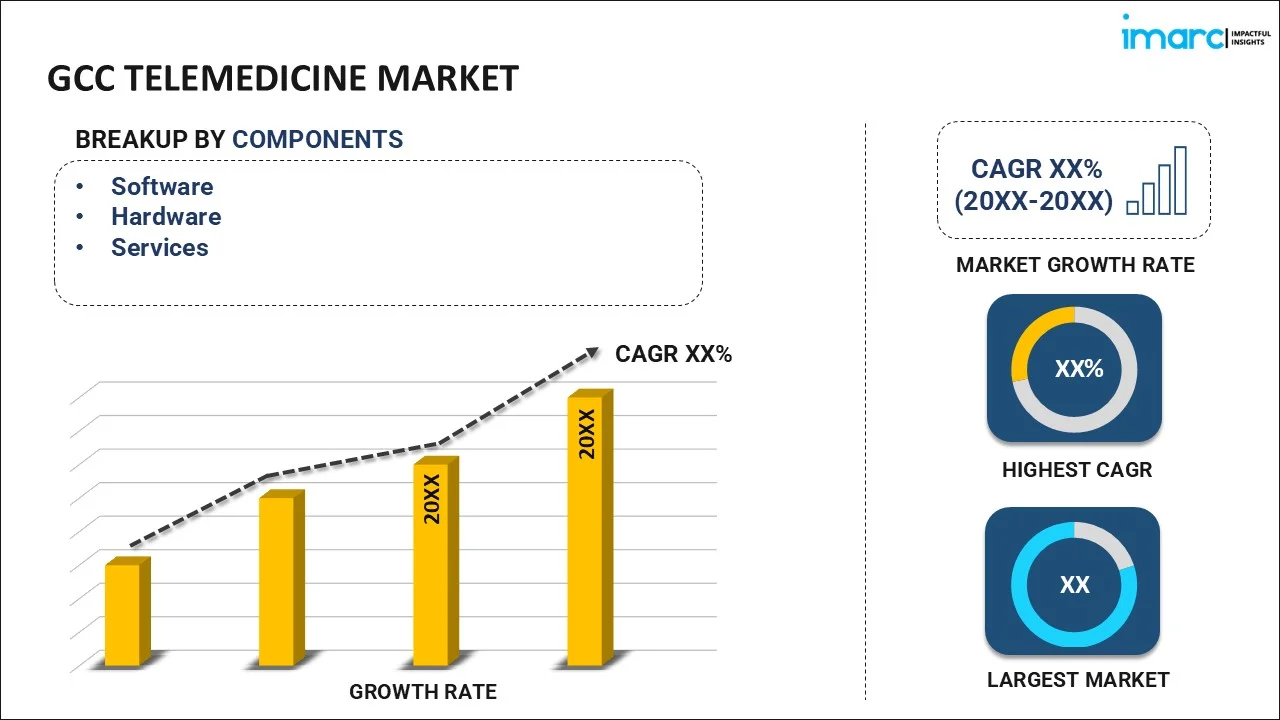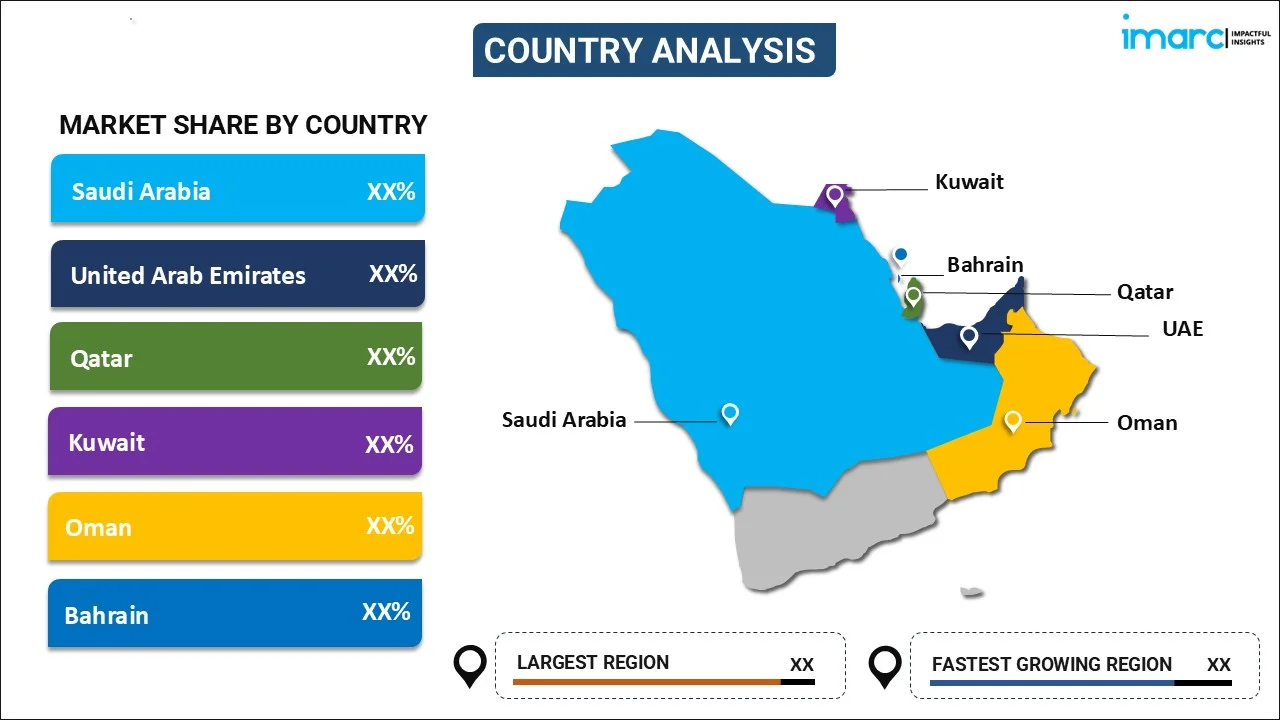
GCC Telemedicine Market Report by Component (Software, Hardware, Services), Communication Technology (Video Conferencing, mHealth Solutions, and Others), Hosting Type (Cloud-Based and Web-Based, On-Premises), Application (Teleconsultation and Telementoring, Medical Education and Training, Teleradiology, Telecardiology, Teleneurology, Telepsychiatry, Tele-Dermatology, and Others), End User (Providers, Patients, Payers, and Others), and Country 2025-2033
Market Overview:
The GCC telemedicine market size reached USD 1.7 Million in 2024. Looking forward, IMARC Group expects the market to reach USD 9.5 Million by 2033, exhibiting a growth rate (CAGR) of 19.1% during 2025-2033.
|
Report Attribute
|
Key Statistics
|
|---|---|
|
Base Year
|
2024
|
|
Forecast Years
|
2025-2033
|
|
Historical Years
|
2019-2024
|
|
Market Size in 2024
|
USD 1.7 Million |
|
Market Forecast in 2033
|
USD 9.5 Million |
| Market Growth Rate 2025-2033 | 19.1% |
Telemedicine refers to the remote delivery of medical services by using a telecommunication network. These services are provided by adopting numerous portals, such as mobile health (mHealth) applications, video conferencing, remote patient monitoring (RPM), etc. Telemedicine helps in enhancing clinical management, providing access to high-end healthcare services, minimizing variations in diagnosis, etc. As a result, it is utilized across several medical specialties, including radiology, psychiatry, cardiology, neurology, dermatology, etc.
In the GCC region, the rising digitalization of healthcare services along with increasing adoption of remote patient monitoring solutions is primarily driving the demand for telemedicine. Furthermore, the growing geriatric population, who are more prone to chronic ailments leading to muscular impairment, is also propelling the need for remote delivery of medical services in the region. Additionally, the increasing popularity of smart wearable devices has enabled healthcare professionals to collect real-time patient statistics and provide accurate telemedicine services. Besides this, the introduction of numerous initiatives by several health organizations in the GCC region for promoting the adoption of eHealth solutions is also catalyzing the market growth. In the coming years, the emergence of various advanced technologies, such as AI, cloud computing, picture archiving and communication system (PACS), etc., in the telemedicine sector will further continue to drive the GCC market.
Key Market Segmentation:
IMARC Group provides an analysis of the key trends in each sub-segment of the GCC telemedicine market report, along with forecasts at the regional and country level from 2025-2033. Our report has categorized the market based on component, communication technology, hosting type, application and end-user.
Breakup by Component:

- Software
- Hardware
- Services
Breakup by Communication Technology:
- Video Conferencing
- mHealth Solutions
- Others
Breakup by Hosting Type:
- Cloud-Based and Web-Based
- On-Premises
Breakup by Application:
- Teleconsultation and Telementoring
- Medical Education and Training
- Teleradiology
- Telecardiology
- Teleneurology
- Telepsychiatry
- Tele-Dermatology
- Others
Breakup by End User:
- Providers
- Patients
- Payers
- Others
Breakup by Country:

- Saudi Arabia
- UAE
- Qatar
- Oman
- Kuwait
- Bahrain
Competitive Landscape:
The competitive landscape of the industry has also been examined with some of the key players being Abu Dhabi Telemedicine Centre, Aster DM Healthcare, Cerner Corporation, CISCO Systems Inc., GE Healthcare (General Electric Company), GRANTEQ LLC, Health at Hand, Koninklijke Philips N.V., Life Gulf Assistance and Okadoc Technologies FZ-LLC.
Report Coverage:
| Report Features | Details |
|---|---|
| Base Year of the Analysis | 2024 |
| Historical Period | 2019-2024 |
| Forecast Period | 2025-2033 |
| Units | Million USD |
| Segment Coverage | Component, Communication Technology, Hosting Type, Application, End User, Country |
| Countries Covered | Saudi Arabia, UAE, Qatar, Oman, Kuwait, Bahrain |
| Companies Covered | Abu Dhabi Telemedicine Centre, Aster DM Healthcare, Cerner Corporation, CISCO Systems Inc., GE Healthcare (General Electric Company), GRANTEQ LLC, Health at Hand, Koninklijke Philips N.V., Life Gulf Assistance, Okadoc Technologies FZ-LLC |
| Customization Scope | 10% Free Customization |
| Post-Sale Analyst Support | 10-12 Weeks |
| Delivery Format | PDF and Excel through Email (We can also provide the editable version of the report in PPT/Word format on special request) |
Key Questions Answered in This Report
We expect the GCC telemedicine market to exhibit a CAGR of 19.1% during 2025-2033.
The rising demand for telemedicine across various medical specialties, including psychiatry, cardiology, neurology, dermatology, etc., as it aids in enhancing clinical management, providing access to high-end healthcare services, minimizing variations in diagnosis, etc., is primarily driving the GCC telemedicine market.
The sudden outbreak of the COVID-19 pandemic has led to the growing adoption of telemedicine services across several GCC nations to remotely monitor, diagnose, and provide consultation to the coronavirus-infected patients.
Based on the component, the GCC telemedicine market can be segmented into software, hardware, and services. Currently, software holds the majority of the total market share.
Based on the communication technology, the GCC telemedicine market has been divided into video conferencing, mHealth solutions, and others, where mHealth solutions currently exhibit a clear dominance in the market.
Based on the hosting type, the GCC telemedicine market can be categorized into cloud-based and web-based and on-premises. Currently, cloud-based and web-based accounts for the majority of the global market share.
Based on the application, the GCC telemedicine market has been segregated into teleconsultation and telementoring, medical education and training, teleradiology, telecardiology, teleneurology, telepsychiatry, tele-dermatology, and others. Among these, tele-dermatology currently holds the largest market share.
Based on the end user, the GCC telemedicine market can be bifurcated into providers, patients, payers, and others. Currently, patients exhibit a clear dominance in the market.
On a regional level, the market has been classified into Saudi Arabia, UAE, Qatar, Oman, Kuwait, and Bahrain, where Saudi Arabia currently dominates the GCC telemedicine market.
Some of the major players in the GCC telemedicine market include Abu Dhabi Telemedicine Centre, Aster DM Healthcare, Cerner Corporation, CISCO Systems Inc., GE Healthcare (General Electric Company), GRANTEQ LLC, Health at Hand, Koninklijke Philips N.V., Life Gulf Assistance, and Okadoc Technologies FZ-LLC.
Need more help?
- Speak to our experienced analysts for insights on the current market scenarios.
- Include additional segments and countries to customize the report as per your requirement.
- Gain an unparalleled competitive advantage in your domain by understanding how to utilize the report and positively impacting your operations and revenue.
- For further assistance, please connect with our analysts.
 Inquire Before Buying
Inquire Before Buying
 Speak to an Analyst
Speak to an Analyst
 Request Brochure
Request Brochure
 Request Customization
Request Customization




.webp)




.webp)












